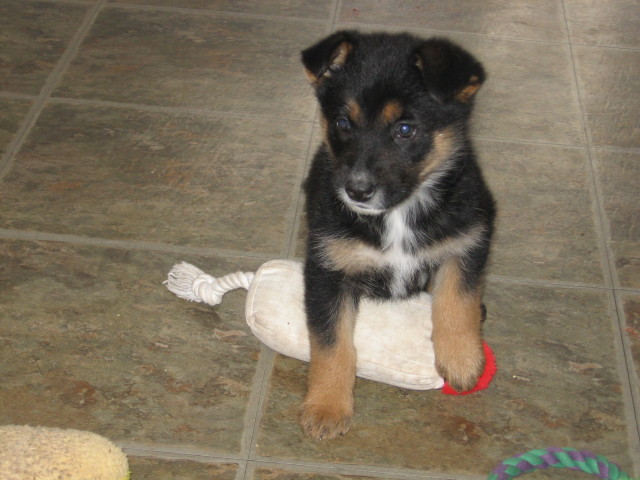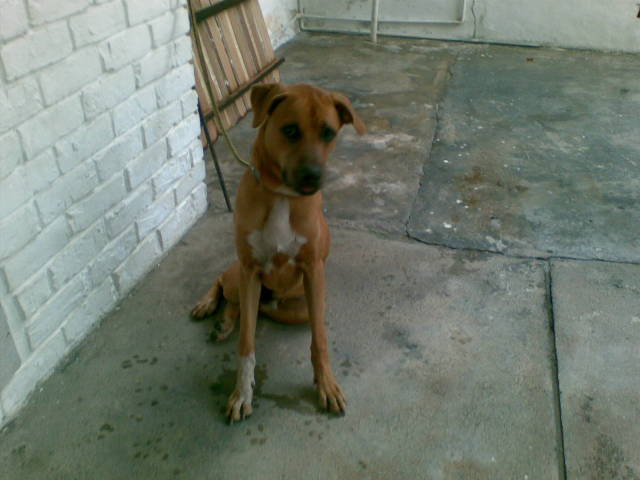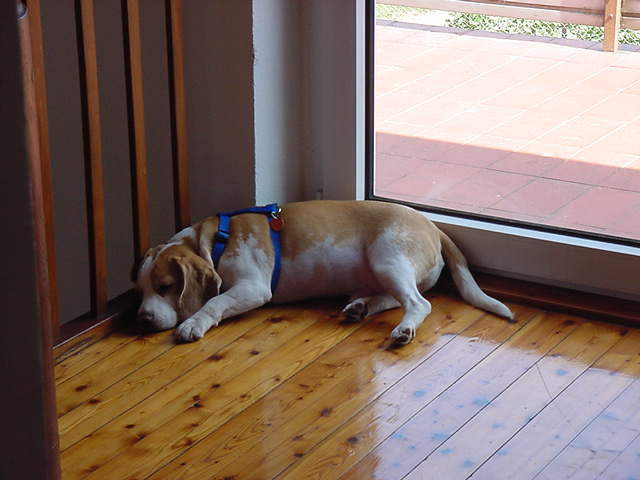QuestionI have an 18 month old female wheaten terrier who, up until about three months ago, had been very well behaved and social with anyone. Over the past three months, she has become extremely aggressive with teen aged boys, they seem to be her target, she has bitten three of them (nipped) and tried the forth unsuccessfully as we got to her leash and pulled her back. We live beside a park, where the children have a fence between her and them and I believe they tease her through it. We have been working on the "alpha" in the past month, she no longer sleeps on our bed or goes on the furniture, she is kennelled again when we are not home, she is being fed by hand by us at this time as we've been told that she needs to realize that she needs us for food and freedom. A lot of what we've done has made our house a much more pleasant environment, however she is still extremely aggressive if she sees a teenage boy, or one comes to the door, she loses her mind, growling, baring her teeth, etc. We've bought a muzzle for her now when she is around our nephews, (six and 18 months) for peace of mind... not sure what else we can do to restore her back to her friendly with everyone personality. Please help!!!
AnswerFor the purpose of general information (because many people read my posts): The entire philosophy of "alpha" training is dead wrong. First: dogs don't live in packs in the manner of wolves and are so far separated from wolves as to make any comparison a nonsequitur. A domestic dog "pack" is a loosely structured organism formed artificially (if there are three or more dogs in a household) based upon emotional comfort or (in the case of free roaming dogs) for the purpose of "hunting" and the "leader" or "alpha" is (as can be seen even in wild dogs or for that matter wolf packs) often situational. Second: much of this "alpha" training philosophy involves subjecting a dog to human behaviors which result in fear, mistrust and avoidance. Even in the wolf pack (which, again, has no relevance to domestic dog behavior), the "alpha" "rules" by acquiescence, NOT subjugation, coercion or physical confrontation. And quite importantly: WE are NOT DOGS and dogs know this. We are created conspecifics (if it's done right). Dogs observe us closely for cues regarding our emotional state(s) and constantly offer cues regarding their own emotional states; they don't understand that we can't (usually) read those signals and they certainly don't understand OUR signals, so when we begin to offer behaviors that are clearly out of context, lack of trust and fear are the results. Third: this so-called "alpha" training also involves other extremely counter productive things such as roll overs, scruff shaking, and even sometimes physical abuse. I'm not suggesting that YOU do ANY of this but, as stated above, people other than the questioner often read my posts and I want it to be absolutely clear that this sort of "training" is so extremely outdated and so far from what we know about teaching animals to do anything as to be not only useless but dangerous.
Hand feeding a dog really ought to involve "teaching" the dog behaviors s/he can then FREELY (voluntarily) offer (in future) for praise and random reward. I'm very much against hand feeding any dog its entire daily portion (twice daily) of food. This flies in the face of the dog culture which is: "..if it's yours, YOU can HAVE IT; if it's MINE, you have it COMPLETELY if I give it to you". Tentatively offering something a dog absolutely requires in order to live creates anxiety. No one should be anxious around mealtime.
Your dog does not have to sleep in your bed or bedroom in order to be happy, that's quite true! Some dogs are not temperamentally suited for this luxury. Whether your dog is one of them I can't determine because I can't see anything from here, but I do know this: at 18 months of age she is demonstrating active DEFENSE AGGRESSION toward someone who HAS EARNED IT, she is NOT directing it at YOU or any other "innocent" party. The Wheaten is a breed often produced for profit by people who care nothing for temperament or type. When bred properly, this is a wonderful breed but I've seen many (many) with temperament problems. Your dog MAY NOT be one of them. She has developed a defense aggression toward a specific type of human because SOMEONE has CREATED IT. There is absolutely NO NEED for this dog to be forced into the situation that created this problem. That dog has NO BUSINESS being left outdoors on her own. Whoever is responsible for this 'teasing' needs to be held accountable for it, and I mean ACCOUNTABLE. If at all possible, an attempt to determine which of these teenage boys elicits this fear response the most should be made. It's more than "teasing" that has resulted in a dog with a heretofore solid temperament to suddenly display active fear aggression. Someone has done something TO HER (hit her with a stick, thrown rocks, etc.) that suggests that "someone" may have a serious emotional problem and I'd want to know WHO IT IS if I were you.
Confining her to the crate when you are not at home (or to a safe space such as the kitchen) is fine so long as she isn't in there for hours at a time; the crate must also be LARGE, with space enough to separate water dish and allow her to move around freely. If you put this dog on NILIF (Nothing In Life is Free) you will then be addressing her anxiety in a manner that's more propitious. It will solidify her trust in you and eliminate the "need" for hand feeding. At meal times, put the bowl down, ask for "sit" (as you do during NILIF) and then tell her "ok" and WALK AWAY to let her eat. Teach her to "sit" using reward in the following manner:
http://home.gci.net/~divs/behavior/bemod_relax.html
Learn about the psychology behind NILIF here:
http://www.vin.com/VINDBPub/SearchPB/Proceedings/PR05000/PR00470.htm
Because she has such a pronounced fear of teenage boys and I can't OBSERVE IT, I think you absolutely must consult a certified applied animal behaviorist. This professional will evaluate her overall temperament and bidability and will be able to observe her reaction to human types (teenage boys) that elicit this fear. How she behaves on leash restraint (with you at the other end AND with a non-caregiver at the other end) and at the front door when these types approach must be observed. She cannot EVER be allowed to be in a position where ANYONE can tease, taunt or in any other way abuse her so whatever is involved in keeping her free of that fence needs to be done and she cannot be allowed unsupervised in any area where other people can freely interact with her. The primary "rule" of dog ownership is: PROTECT THE DOG. People are capable of anything; a worker in your home can kick your dog when you're not looking (and they DO); a neighbor who is otherwise "normal" can do harm, a visitor (especially children) is capable of doing just about anything (especially CHILDREN who don't know better) and all it takes is ONE ten second interaction to create a serious behavior problem that will cost the dog its life. Your dog has already bitten three times, she's progressing, if this continues she will pay the ultimate price and that's totally unnecessary. I realize you're doing ALL you can and I applaud you for your effort, but I can't fix this from here (and neither can anyone else). You can find a behaviorist at one of the following site, be certain to avoid dog trainers, you absolutely require someone with credentials:
http://certifiedanimalbehaviorist.com/page6.html
http://www.animalbehavior.org/ABSAppliedBehavior/caab-directory
MEANWHILE, do not allow the dog to greet anyone at the front door (especially teenage boys!) If someone rings the bell or knocks unexpectedly, calmly remove her to another room where she can't see the person (do NOT crate her) and offer her a reward, then go to the door. What we DO NOT want is any further development of her fear which can begin to generalize to everyone (not just teenage boys). In terms of her interaction with your grandsons (or any other children who visit), err on the side of caution for all concerned: PROTECT THE DOG. Confine her to the room you've chosen with interesting toy (like a Buster cube which dispenses a portion of her daily food as she rolls it around), soft bed and fresh water. The muzzle communicates something to the dog we want to avoid; dogs know they're inhibited physically while wearing the muzzle and, should the dog become fearful her circumstance will contribute greatly to her fear. There's no reason such young children need to interact with any dog. Be sure the door is locked securely so no one can get entry to the room without your knowledge. Confine her well before the visit (five to ten minutes). Upon professional evaluation and ongoing behavior modification, there may be no further need for this but young children and dogs do not mix and a dog with a fear aggression problem really should not be put into a position to test his/her reliability around children.

 puppy problems
QuestionQUESTION: I am the proud owner of 2 german shep
puppy problems
QuestionQUESTION: I am the proud owner of 2 german shep
 Agressive 1 yr old mini goldendoodle
Question
our millie
My husband and I got our min
Agressive 1 yr old mini goldendoodle
Question
our millie
My husband and I got our min
 dogs behaviour
QuestionMy 8 months old Dusto
QUESTION: My puppy
dogs behaviour
QuestionMy 8 months old Dusto
QUESTION: My puppy
 Dog light and shadow chasing
Question
Jenni
My 3 year old Cavalier King Charles Span
Dog light and shadow chasing
Question
Jenni
My 3 year old Cavalier King Charles Span
 licking the floor not stop
QuestionGeorgie
QUESTION: Hi,
I have a 7 year ol
licking the floor not stop
QuestionGeorgie
QUESTION: Hi,
I have a 7 year ol